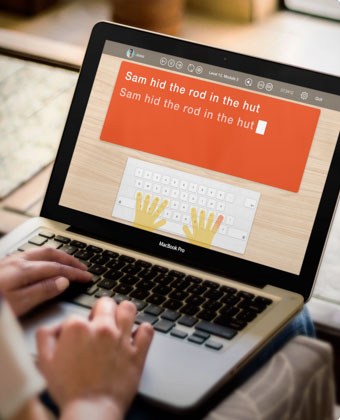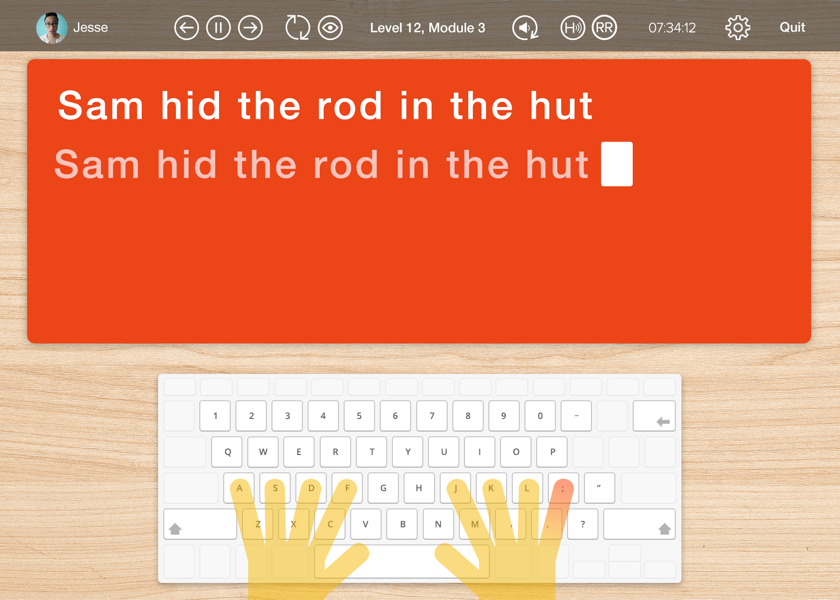
Uses structured word lists from the book 'Alpha to Omega' by Dr. Beve Hornsby – based on the Orton-Gillingham approach

Dyspraxia is a type of Developmental Coordination Disorder (DCD) that affects fine and gross motor skills, impacting an individual’s ability to perform, plan and coordinate movements.
According to the UK Dyspraxia Foundation, an estimated 10% of the population struggles with some form of dyspraxia and 2-4% of people experience severe symptoms. Yet as it is less well known than other disorders, it may not always be recognized and/or diagnosed in children and adults.
People can have different forms of the disorder and no two individuals will experience it in exactly the same way. Some individuals are affected by clumsy movements and poor posture, whereas others have trouble with the basic coordination needed for self-care, including dressing, bathing and feeding themselves.
At school, one of the first signs of dyspraxia is a child with an unusual grip of the pen or pencil, an awkwardly placed wrist and/or difficulties forming the basic shapes of letters and spacing words - although it is easy to mistake dyspraxia for dysgraphia or dyslexia.
Dyspraxia can also cause a child to require extra time due to slow processing, and make it difficult for them to remember what they have learned. Students may need help breaking tasks into steps, following instructions, staying organized and/or negotiating handwriting.
If dyspraxia is suspected, an occupational therapist or physiotherapist can make a diagnosis based on observed motor skills deficiencies as compared to same-age peers. They must also confirm that the motor skills delay and coordination difficulties are not caused by any other disorders or physical impairments. If language is impacted, it’s important the child visits a speech and language therapist as well.
Dyspraxia does not go away with adulthood, but it can get better when the right coping strategies are put in place. These strategies may be recommended by your school, a private tutor or an educational psychologist.
Above all, it’s crucial that kids with dyspraxia be given access to accommodations and plenty of emotional support to help them stay motivated and achieve their full potential in the classroom.
I ordered TTRS immediately after seeing it. I had been thinking about how to teach keyboarding to my ten year old son who has dyspraxia. Printing and cursive are hard and tedious for him but he enjoys the TTRS course and is so proud when he sees his scores. He needs the repetition of spelling the words also. I'm so happy that we found it!
– Mary O., Parent of a child with dyspraxia
And follow us:
Different forms of dyspraxia
Ideomotor dyspraxia
This is when one-step motions pose difficulties, for example petting a dog or pulling a handle. Dyspraxia can also be ideational, which refers to trouble executing a series of movements needed for the coordination of actions, like closing a zipper or writing using a pen or pencil.
Constructional dyspraxia
This form of dyspraxia may show up if a child has a hard time understanding how objects relate to each other spatially. These kids may avoid playing with blocks, Legos or other building toys. If dyspraxia occurs with ADHD it is called DAMP or Deficits in Attention, Motor Control and Perception.
Verbal apraxia
Dyspraxia that impacts language skills goes by many names including oromotor dyspraxia, apraxia of speech, and/or Developmental Verbal Dyspraxia (DVD) in the UK. Children will typically slur their words and may be hard to understand because of problems with enunciation. However, unlike in dysarthria, slurred speech is not caused by weakness in the muscles, but rather a difference in the way the brain sends messages to the body regarding the movement sequences and muscle coordination required to form speech.
Is it a learning difficulty?
While dyspraxia has been referred to as a motor learning difficulty, the US and UK governments do not class it as a learning disability in the same way as they do dyslexia, ADHD and dysgraphia. But while dyspraxia has nothing to do with intelligence, it can impact on learning, particularly when it affects writing, speaking skills or computer use.
It’s also important to keep in mind that dyspraxia may occur alongside specific learning difficulties.
Accommodations and strategies
Because dyspraxia can impact on a student’s ability to perform a range of everyday skills, it’s important to assess each child individually and develop a plan of strategy use and accommodations to suit their needs.
-
Help them stay organized.
Planning issues can be helped by putting some simple organizational strategies into place. Start by attaching a class schedule to a notebook with days and times highlighted in different colors. You might introduce stickers or a color-coded folder system for storing and organizing homework. Make sure the child is involved with setting up the system and then observe them to ensure they are actually making use of it. You can always come up with a new approach if the student is still struggling to stay organized.
-
Order special school supplies.
When kids with dyspraxia experience writing difficulties, it can cause handwriting to be physically painful. For some children, pencils with rubber grips or thick markers are easier for them to hold. A child may also have trouble writing in a straight line, spacing words or forming letters. Consider giving them graph paper or lined paper with bigger margins and introducing a ruler or other tool that they can use to guide their work.
-
Allow them to use a computer.
If students with dyspraxia are expected to follow along with a lesson and produce written notes at the same time, they may struggle. Teaching touch-typing and allowing the use of a computer in class can make it much easier as it automatizes the writing process and helps with copying too. You might also set them up with a note-taking buddy.
TOP TIP:
Not just every typing program will work for a child with dyspraxia. Multi-sensory approaches that focus on accuracy over speed take a dyspraxia-friendly approach.

-
Repeat yourself and chunk information.
When delivering a lesson, teachers can routinely stop to go over information that’s already been covered. The more repetition, the easier it is for students with dyspraxia to process and store the information. It can also help to further organize details into categories and provide visuals aids and mnemonic devices to help students learn and remember new ideas.
-
Go over task instructions carefully.
This is particularly important for assignments that have multiple steps. Provide both written and verbal instructions and emphasize the correct sequence and approach through modelling. Ask students questions to ensure they have understood the task. It’s also useful to have another member of staff look over your instructions and ensure each numbered step only contains one direction.
-
Provide time updates to keep kids on task.
Children with dyspraxia may have a hard time pacing themselves and it can help to remind them to move on at regular intervals. You might hold up a sign every fifteen minutes, use a large paper clock and move the hands or come up with an audio signal such as a bell or whistle that is played at certain intervals. Just keep in mind dyspraxic kids may also need more time so let them know they can continue projects at home if they don’t finish in class. You could also try reducing the amount of work they are expected to do in a given period and evaluating them on quality vs. quantity.
-
Minimize distractions in their environment.
You might have a child sit at the front of the room or find a quiet corner in which they can work. The less distractions, the easier it will be for them to focus and receive extra support. Try to make regular eye contact as well and check in often to see how they are doing. These are useful techniques for kids who struggle with ADHD as well.
-
Lower anxiety and keep them calm.
The symptoms of dyspraxia can be worse under stressful conditions. Sometimes playing classical music at a low volume can help children focus or have the window open to ensure there’s fresh air circulating. You might model good posture and remind them to sit up straight and take big breaths. It’s also good to encourage kids to get up and move around the room from time to time or to go outside and have a quick run around to help them focus when they come back to the classroom.

Make use of technology
One of the best ways to facilitate writing when a child has dyspraxia is to teach touch-typing on a computer keyboard. Typing without looking at the keyboard is a process that automatizes the translation of thoughts and ideas into written language and removes the struggles dyspraxic kids face with letter formation, gripping a writing utensil and spacing words on a page.
It’s also useful for editing any voice-to-text compositions they produce and working on longer assignments and essays.
Note that if the child has severe dyspraxia and finds it difficult to use a keyboard, new voice-to-text technology is becoming more accurate every day and you are likely to find a dictation feature on most mobile devices and laptops.
Motivation, encouragement, and self-esteem
Helping a child learn how to process and deal with their emotions can be tricky, but when a student is also struggling with dyspraxia, it is particularly difficult. Dyspraxia is sometimes associated with immature behaviour or impulsivity.
Not being able to use a pair of scissors like the other children in class, or ride a bike at the park with friends can be embarrassing and take an emotional toll on dyspraxic children.
This is made worse when performance at school is poor, no matter how much effort a child puts into their work. Frustration and feelings of low-self worth can cause students to act out and develop negative associations with school and learning.
Nonetheless, those kids with dyspraxia who get the emotional support and encouragement they need, can learn to stay motivated and persevere in the face of challenge. In fact, many dyspraxic adults attribute their inner strength and resilience to having had to work so hard as a child.
Teachers and parents can help by providing plenty of opportunities for success, avoiding comparisons and praising effort over results.
Touch-typing and how it can help
Touch-type Read and Spell was developed to provide step-by-step learning so kids with dyspraxia, dyslexia and other learning difficulties can work through a typing program at their own pace.
Students learn touch-typing skills to help them be more successful at school, but also strengthen their reading and writing skills at the same time.
In addition to discovering the keyboard, the program is built around a structured program of phonics that emphasizes the basics of English spelling and strengthens decoding in reading.
Instead of being speed focused, TTRS praises accuracy and effort. It also divides the learning into bite-size modules so progress is incremental and students build confidence as they see their scores go up.
Modules are short and manageable. This helps children to feel and be successful, and enhances self-esteem and confidence in themselves as learners.
If you’d like more information on TTRS, sign up for a free trial to see if it can help your child with dyspraxia.
TTRS is easy to follow. The finger display option is useful at the start and easily removed when the user becomes more advanced. My child enjoys it too.
– Georgina Maddox, UK, Parent of child with dyspraxia, dyslexia and dyscalculia

For learners with dyspraxia
Unlock writing ability with touch-typing and increase confidence in the classroom
How typing can help
When writing by hand is physically painful, typing on a computer or tablet is a recommended alternative.
- Improve fluency, accuracy, and ease of written production
- Type classroom notes, homework assignments, essays and open-answer questions on quizzes and exams
- Strengthen spelling and reading skills
- Enhance working memory
- Build confidence and foster independence through self-directed learning

With Touch-type Read and Spell…
- Learning to type is easy and fun
- Lessons are modular and learners set the pace of study
- Focus is on accuracy and effort vs. speed and performance
- Gamified learning, including points, trophies and certificates, motivate students to succeed
- Modules can be reviewed and repeated as necessary
- Progress is visible with easy-to-read graphs
- Students can work independently or with a tutor
Why parents and homeschoolers love TTRS
It requires minimal supervision
It builds focus and concentration
It boosts confidence and self-esteem
It doesn't look or feel like a literacy solution
There’s arithmetic practice too
The whole family can use it
Frequently asked questions
My child struggles with fine motor skills coordination, will he or she be able to touch-type? Many learners with dyspraxia have found success with TTRS stating that it is easier for them to press keys on a keyboard than it is to write by hand. However, we understand that no two cases of dyspraxia are the same. If you find the program is not a good fit, get in touch with our team and we’ll send you a full refund.
How long will it take for typing skills to emerge? Students with dyspraxia often require extra time to master the key strokes in touch-typing and this kind of flexibility is built into the course. It could take several weeks or several months and is partially dependent upon the severity of the dyspraxia and how often and for how long your child practices. We recommend at minimum 10 minute practice sessions 3-4 times per week.
Does my child have to use the correct fingers to type? No! Some learners use TTRS to develop dexterity and muscle coordination. There is even a one-handed version of the course that can be used if traditional touch-typing finger placement is not desired.
My child also has dyslexia – will TTRS be of use? TTRS can make a big difference in the reading and spelling ability of dyspraxic learners with dyslexia. Our multi-sensory typing method involves hearing a sound, seeing it on the screen and typing the corresponding keys, combining sensory input to make words more memorable.
Will the course help my son or daughter with attention based difficulties? Yes! TTRS is split into bite-size modules and automatically remembers a user's place, so it is easy to just sit down and get typing. There are also no distracting graphics and the navigation menu is simple and focused to keep learners on task.
Will TTRS help in cases of apraxia of speech? The TTRS program is specifically designed to help users learn English sounds and letter combinations. If a hear it, see it, type it, and say it approach is adopted, learners with apraxia of speech may begin to retrain the muscles needed to produce complex sequences of sound.



